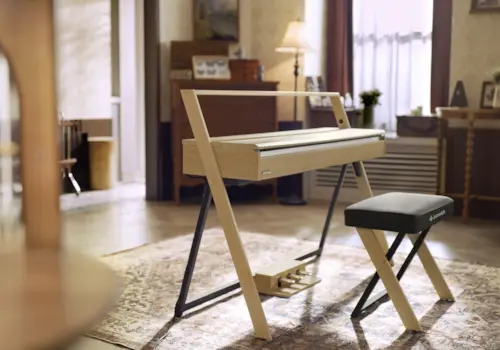Inge Kjemtrup consults three experts – Nigel Scaife, John Kember and Pam Wedgwood – for tips
So, you’ve decided to take up the challenge of writing an original piece – congratulations! Whether you’re a novice composer or you’ve already tried your hand at writing a piece, you may be wondering how to begin.
To answer these questions, I’ve spoken with three pros: music educator Nigel Scaife, composer, arranger and pianist John Kember, and Pam Wedgwood, music educator and composer for Faber Music. All three offer practical advice based on their own experiences – advice that we hope will make you sit down and commit your music to paper (or computer). You may even want to enter it into the 2024 Pianist Composing Competition (the winner receives a Kawai piano!).
How can I turn that little tune that I’ve made up into a fully-fledged piece?
John Kember: Consider the overall form. A simple A-B-A pattern will work for a short piece. Don’t be afraid to repeat a phrase, and avoid too many rhythmic patterns. Look at a few tunes that are ‘catchy’ and see how the tune develops. It also helps to think ‘question and answer’ to develop a first phrase.
Pam Wedgwood: Find a few basic chords that sound right with your melody. When you have played around for a while, things may emerge naturally. Don’t be afraid to follow your instincts! After a while, you can start thinking about a structure. You could start with tune A (your original melody), follow it with tune B (an answering phrase in a relative key) and then go back to tune A. Use different textures and colours to make your piece as interesting to the listener as possible. Whatever you write will be an original work – no one else has written it before!
Nigel Scaife: Ask yourself lots of questions, such as ‘What could act as a useful contrast?’, ‘How could this idea be extended?’ or ‘Should there be some kind of introduction or coda?’ Improvising can often be a really useful way of discovering new possibilities. Simple but strong musical ideas and well-chosen sounds can be hugely effective, so don’t feel that your piece has to stretch pianistic technique.
How can I create a left-hand part to accompany the melody? How do I know if the harmony is ‘right’?

©Pixabay
JK: Writing the left-hand accompaniment depends on the style you are creating, and what you feel comfortable playing yourself. Avoid trying to be too clever or complicated. Test the harmony by playing the outer parts on their own. The rules are there to help us but if it sounds good to you, then stick to it!
NS: Try adding a simple bass line first as that will give it a harmonic foundation. Spend time thinking through the musical ideas in your head before translating them to the keyboard. You might find it helpful to write them down in an abstract way, as that may take you in a new direction and you may find other material that goes well with the original idea. You could then add in chordal material or an accompaniment figuration to fill out the texture.
PW: Creating a left-hand part for your melody is very much an experimental exercise. Once you have established the chords you are going to use it will depend on the style that you intend to write as to what the left hand will be doing. Your melody could also be in the left hand!
Which style should I write in?

Johann Sebastian Bach is one of Baroque's most successful composers
PW: It is perfectly fine to write your piece in any style. In fact, it’s great practice to try and do this as a composition exercise. Look at the fairly simple pieces by the great composers and work out how they used structure and keys. Don’t be frightened to copy their ideas; you don’t have to write the same notes!
JK: Try all sorts of styles. You could try a folk tune (modal, perhaps), a contrapuntal (two-part) piece, a ballad or more romantic style, even something more contemporary based on rhythms rather than melody.
What about writing it down – should I use manuscript paper or is there a simple notation programme I could use?

©Shutterstock
JK: Pencil first, computer last. I always write with a pencil on manuscript paper and do all edits and improvements first. Only when it’s finished do I use a computer (an old version of Sibelius that I am familiar with).
NS: One tip that I have found useful when hand writing music is to use a bank card, or any plastic card of that type such as a library card, and keep that in your left hand (assuming you’re right-handed) to write the bar lines and beams neatly.
PW: Writing down music is quite laborious but is a very good way to learn about how musical notation is written. You might want to explore the possibilities of using Sibelius or even Dorico in the future. It’s a fantastic way of producing music and I wouldn’t be able to make a living as a composer without it.
Once I have written it down, should I play my piece for others?

©Pexels
NS: It’s always a good idea to play it to someone else, or better still, ask a pianist friend to play it to you without having heard you play it first. That can be really revealing as you may find that their interpretation is quite different from what you expected! It’s quite likely that you will want to adjust certain elements to ensure that your musical intentions are as clear as possible.
PW: Playing your finished work to an audience will depend on how confident you are feeling about it. Try making your own recording of it and then decide if this is a good idea. Once you have completed it, try and feel pleased with yourself that you have managed to put this work together. It’s an amazing achievement for anyone.
What’s the best advice you’ve been given about composing?

©Kawai – Enter our 2023 Pianist Composing Competition here
JK: ‘Edit and improve – but know when to stop.’ Another piece of advice is to consider the form first: ‘If a piece has form, in whatever style, but particularly with contemporary, with a clear form it will work’ (the actual words were, ‘you’ll get away with it!). In short, think about the style first. Rhythmic or melodic, contemporary or traditional? The more modern it is, the more vital that the rhythms are correct (as in a jazzy piece).
PW: The most important bit of advice is to keep your piece as simple as possible. Good luck with your writing, and most of all, enjoy the experience and feel proud of your work.
Header image courtesy of Marc Longwood.










